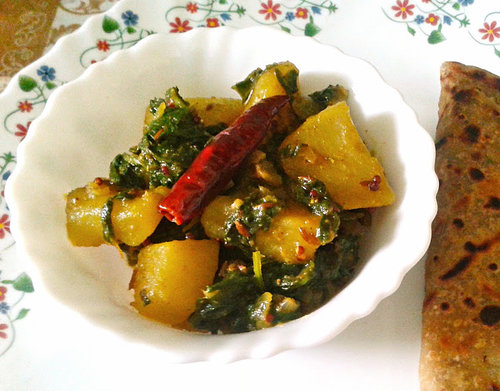

Sweet potatoes and baby leaf spinach are wonderful ingredients, whose flavors complement each other in this delicious dish.
Combined with anti-inflammatory spices such as turmeric, Garam masala, and ginger; it’s a healing dish that is as tasty as it is healing.
I like to serve this simple home-style preparation with Chapatis or Naan bread for a home-cooked meal.
Ginger is moist and dry at the same time and is known as a universal medicine benefiting everybody and all diseases.
Especially good for Vata disorders, this is one of Ayurveda’s best go-to spices. When using ginger, think about digestion, lungs, and circulation. All Vata problems.
Ginger with its pungent and sweet taste warms the digestive system, increases digestive fire (Agni), and helps in the secretion of digestive enzymes. Also useful in nausea, especially travel-sickness, gas bloating, and stomach gripping – it has a specific action against E. Coli and Shigella bacteria.
Ginger is great when used in menstrual cramps as it regulates Vata in the lower abdomen. Despite its warm energy, it also is an anti-inflammatory. It has the properties of being able to warm and cool and is really beneficial for nourishing the reproductive system.
Ginger has a unique effect (prabhava). It’s post-digestive quality is sweet which means its long-term effect is anti-inflammatory and nourishing while its initial effect is warm and stimulating for digestion. That’s good news for anyone that has digestive and inflammatory problems.
Turmeric with its strong yellow color signifies its use as a liver herb that is good at drying damp and moving stagnation in the blood. It is a pungent, bitter, and astringent herb that has a heating effect. It reduces excess Vata and works specifically on the digestive, circulatory, respiratory, and female reproductive systems.
Turmeric helps to promote healthy intestines by reducing pathogenic bacteria and destroying digestive toxins (ama). It has recently been proven to have an affinity for the large intestine and to play a preventative role in bowel cancer. Other clinical trials have proven its efficiency in treating stomach acidity and ulcers. Its bitter and pungent flavors act on the digestive fire to nourish the blood.
It has a stimulant effect on the liver and increases the flow of blood through the hepatic system and increases bile output. This helps dissolve and prevent gallstones. It is traditionally considered a blood purifier and is often used for beautifying the skin and clearing systemic toxemia: eczema, urticaria (itching), psoriasis, and acne.
It treats inflammation of the joints, alleviates pain, and strengthens the joints and tendons. Useful for treating arthritis, especially that dry arthritis of Vata.
Ginger contains Gingerol, a substance with powerful medicinal properties. It has been used to help digestion, reduce nausea and help fight the flu and common cold, to name a few.
Ginger appears to be highly effective against nausea. relieving nausea and vomiting after surgery, and in cancer patients undergoing chemotherapy. But it may be the most effective when it comes to pregnancy-related nausea, such as morning sickness.
Ginger has been shown to be effective against exercise-induced muscle pain. In one study, consuming 2 grams of ginger per day, for 11 days, significantly reduced muscle pain in people performing elbow exercises. Ginger does not have an immediate impact but may be effective at reducing the day-to-day progression of muscle pain. These effects are believed to be mediated by the anti-inflammatory properties.
Osteoarthritis is a common health problem that involves degeneration of the joints in the body, leading to symptoms like joint pain and stiffness. Interestingly in a controlled trial of 247 people with osteoarthritis of the knee, those who took ginger extract had less pain and required less pain medication. Another study found that a combination of ginger, cinnamon, and sesame oil, can reduce pain and stiffness in osteoarthritis patients when applied topically.
Just to note this remedy is often given as an ayurvedic remedy for Vata-type arthritis.
Ginger has been shown to lower blood sugar levels and improves various heart disease risk factors in patients with type 2 diabetes.
Recently, science has started to back up what the Indians have known for a long time… turmeric really does contain compounds with medicinal properties.Turmeric contains curcumin, a substance with powerful anti-inflammatory and antioxidant properties.
Inflammation is incredibly important. It helps the body fight foreign invaders and also has a role in repairing damage. Although acute (short-term) inflammation is beneficial, it can become a major problem when it is chronic (long-term) and inappropriately deployed against the body’s own tissues. It is now believed that chronic, low-level inflammation plays a major role in almost every chronic, Western disease. This includes heart disease, cancer, metabolic syndrome, Alzheimer’s, and various degenerative conditions. It turns out that curcumin is strongly anti-inflammatory, it is so powerful that studies show it matches the effectiveness of some anti-inflammatory drugs.
Curcumin actually targets multiple steps in the inflammatory pathway, at the molecular level. Curcumin blocks NF-kB, a molecule that travels into the nuclei of cells and turns on genes related to inflammation. NF-kB is believed to play a major role in many chronic diseases. In several studies, its potency has been compared favorably to anti-inflammatory pharmaceutical drugs… except without the side effects.
Oxidative damage is believed to be one of the mechanisms behind aging and many diseases. Curcumin happens to be a potent antioxidant that can neutralize free radicals due to its chemical structure.
Curcumin boosts levels of the brain hormone BDNF, which increases the growth of new neurons and fights various degenerative processes in the brain such as Alzheimer’s and depression.
Ingredients
Directions
Place the sweet potatoes in a large saucepan, add 1/2 teaspoon salt, cover with cold water, and cook till the potatoes are tender. Drain, peel, and set aside
Heat the olive oil in a large frying pan, add the mustard seeds, and when they start to pop, add onion, ginger, and garlic. Saute until the onions are tender, add the chili powder, turmeric powder, and garam masala, and saute for a minute.
Add the chopped tomatoes and salt to taste. Cook until the tomatoes are tender and falling apart. Then add the spinach and cook till it’s wilted, add the sweet potatoes and lemon juice, mix well, and cook till all the water is evaporated.
Serve hot with warmed Naan bread or chapatis.
There’s no one size fits all for what you should eat. If you would like to talk with me about what is the right diet for you, sign up for a complimentary consultation. Just click on the link to my online calendar to find a good time that works for you.
In health


The Holistic HIghway integrates traditional Western medical practices with Ayurveda medicine, creating a focus on prevention through nutrition, diet, and exercise; use of the latest genetic testing and other diagnostic techniques; and prescribed combinations of botanical medicines, supplements, therapeutic diets, detoxification programs, or stress-management techniques.

Integrative Health Expert | Ayurveda Practitioner | Author | Speaker
Kerry is a globally recognized leader in integrative medicine and the science of health known as Ayurveda. She is passionate about raising awareness of the need for a change in contemporary medicine that focuses on patient empowerment and a health-based (rather than disease-based) medical system.
Kerry is connected with The University of Pittsburgh Center for Integrative Medicine and remains a pioneer in the field of integrative medicine where she has developed a personalized system to manage chronic disorders by incorporating fundamental changes in diet, behavior, and stress while focusing on genetics.
This individualized program is so successful that many of her clients have achieved maximum healing and vitality after years of chronic problems!
More to Explore
Contact
Disclaimer
The sole purpose of all the website content is to educate and provide information about Integrative Health, Genetics and Ayurveda.This information is not intended for use in the diagnosis, treatment, cure. or prevention of any disease.
Stay Connected
One Response